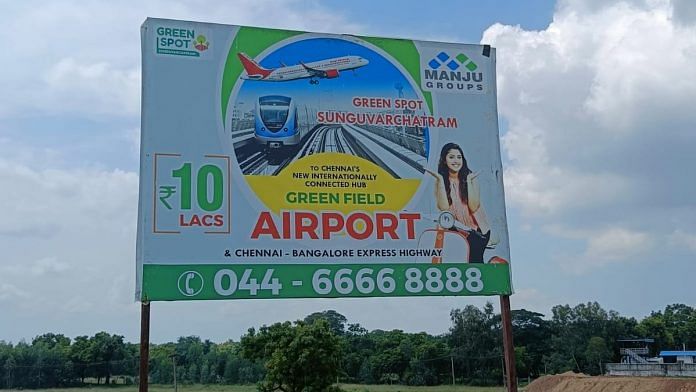Parandur: The village of Nagapattu in Tamil Nadu’s Kancheepuram district appears to have many ecology enthusiasts. Residents Mythili and Vasanthi vie for a spot as they walk ThePrint around the impressive collection of flora in their backyards.
Mythili’s mango tree just turned 10 years old, the drumstick tree 20, and the lush betel leaves that have raced their way up her back wall are averaging five. “Will all this be there where we are asked to move?” she asked.
Nagapattu, a small hamlet with 80 houses, is one of 12 villages earmarked for a new greenfield airport, which will be built on 4,791 acres of land in Parandur, 70 km southwest of Chennai.
The project, estimated to cost about Rs 20,000 crore, is touted as “crucial infrastructure” that will reduce congestion at Chennai International Airport in Meenambakkam, and help the Dravida Munnetra Kazhagam (DMK)-led state government meet its ambitious target of achieving a US$ 1 trillion economy by 2030.
The Tamil Nadu government has said that a new airport is necessary, in addition to the existing one, since passenger volume is expected to rise to 10 crores between 2030 and 2035, from 2.2 crore now. By 2028, which is roughly when the second airport is expected to be up and running, it is expected to increase to 3.5 crore.
But ever since Union Minister of State for Civil Aviation Vijay Kumar Singh announced the site for Chennai’s second airport on 1 August this year, there have been constant agitations by villagers who are dead against parting with their land, used largely to cultivate rice.
The state government has attempted to assuage their concerns numerous times and promised to pay more than 3.5 times the market price for the land, but the agitation reached its hundredth day on 3 November, and villagers continue to voice their opposition to the project.
This agitation is reminiscent of the protests that sprung up when plans were floated for new international airports at Bengaluru and Hyderabad, both of which opened in 2008 after years of delay. Today, both these airports have pushed Chennai’s rank in passenger traffic to fifth place, down from third.
At a 2 November conference in Chennai’s Taj Connemara Hotel, which ThePrint attended, representatives of the state government tried to make their case for the new airport and to address questions around the project.
“The current airport is not fully equipped. So we are certainly in need of a new greenfield airport, which will take care of future demands,” said state industries minister Thangam Thennarasu at the event, which was organised by the Tamil Nadu Industrial Development Corporation Ltd (TIDCO) and the Madras Chamber of Commerce and Industry (MCCI).
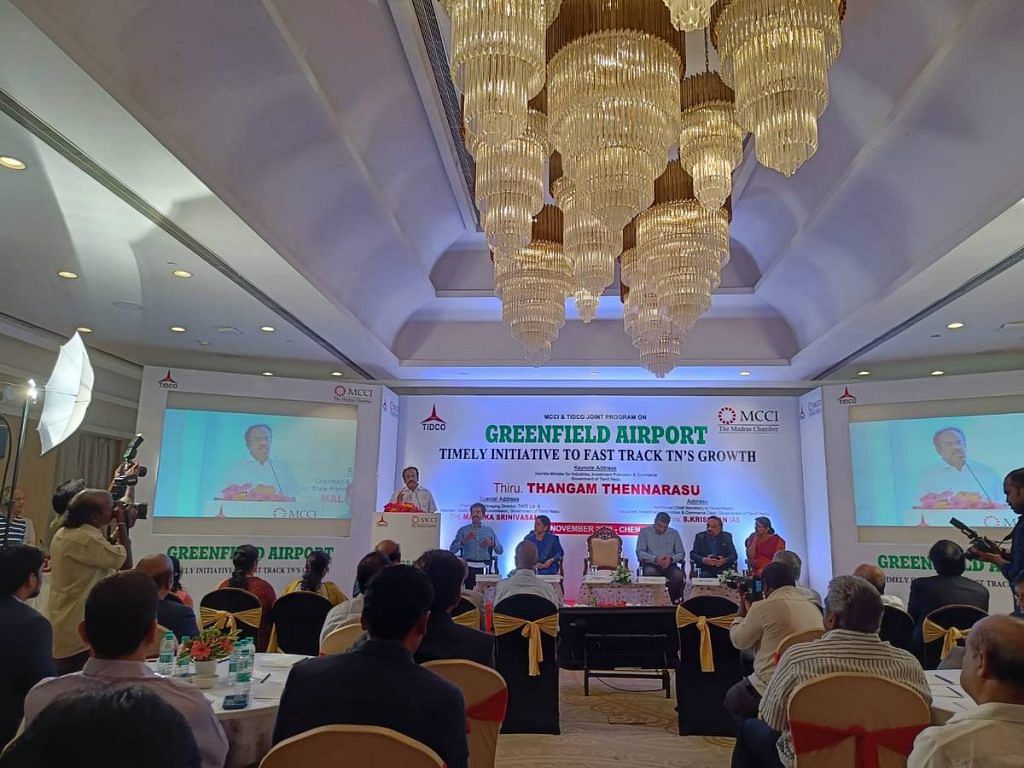
“We are behind Bengaluru and Hyderabad [airports], which are growing faster. So, the capacity expansion is urgently required,” added Mallika Srinivasan, a member of Tamil Nadu’s planning commission.
However, getting buy-in from those who stand to be displaced has proved to be challenging. At villages that ThePrint visited, the residents were irate that they were not part of the consultation process and fearful they would lose their farms — the only means of livelihood for many. Indeed, even villages that had earlier been divided along caste lines seem to have united in their opposition to the project.
Joining in the chorus are environmental activists, who have warned that the airport project could cause floods and wreak ecological havoc since the area comprises wetlands.
Also read: Narmada dam activism helped villagers get better compensation. But not how you think
‘We won’t give even a fistful of mud’
Scenic Ekanapuram village is surrounded by agricultural lands and is a roughly two-hour drive from Chennai. When ThePrint visited on 13 October — day 79 of the protests — the villagers described their daily ritual.
Every night after dinner, when the chores for the day were done, they gather outside the local temple to discuss how to prevent being “erased from the map”, they said. They claimed the government had not carried out any form of public consultation with them and they had learned about the project only from news channels.
“We don’t want this airport, we won’t give a fistful of mud, an inch of our stream, we won’t give up Ekanapuram,” said Chellamma, a village elder who belongs to the Vanniyar community, classified among the Most Backward Classes.
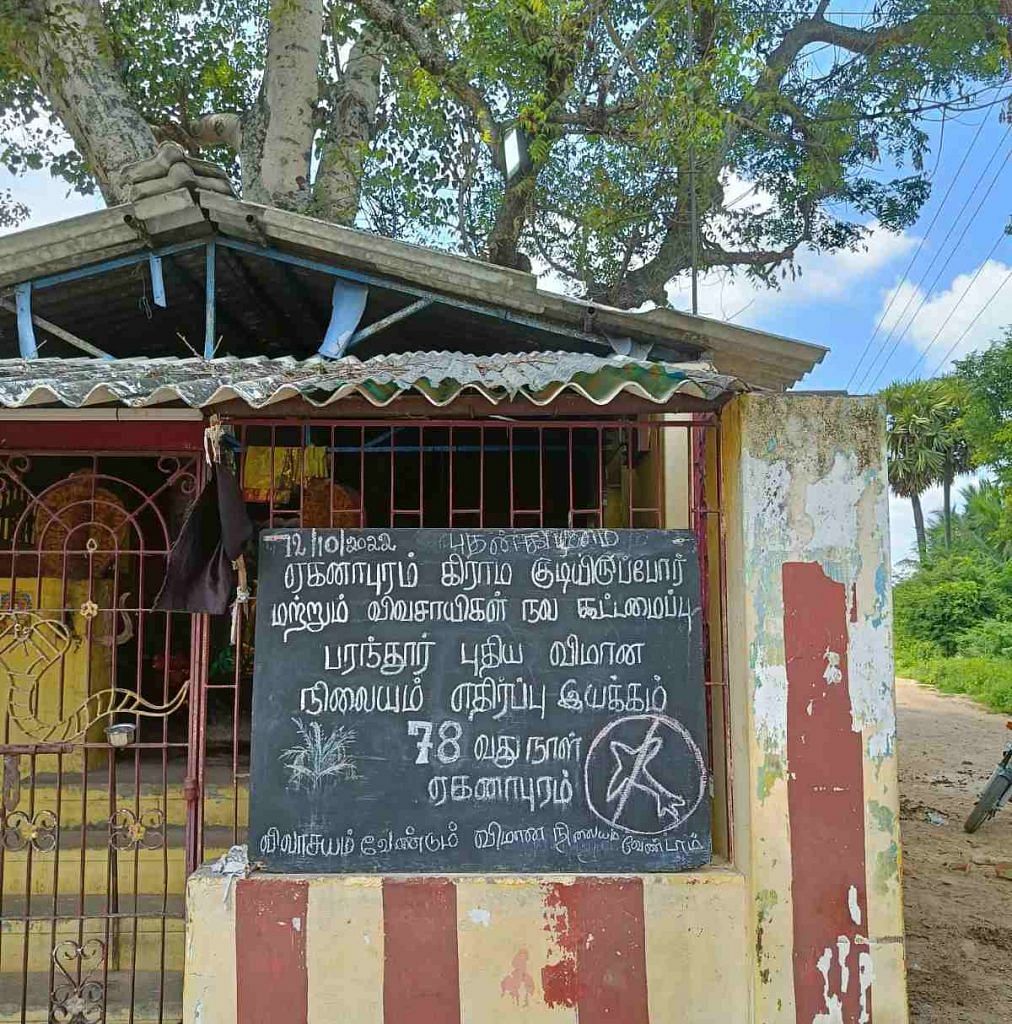
The Vanniyars and Dalits here live in different areas of the village, but now members of both communities sit together in protest. Until recently, a statue of B.R. Ambedkar here reportedly had to be kept under iron grills to protect it from caste Hindu vandals. Now, every evening, people from all communities strategise about their next steps, side by side.
“Ministers have publicly said they held consultations but who did they ask?” said Menaka S., a 33-year-old farm worker. “Now we are living like refugees in our own village, surrounded by police protection. They keep asking us where we are going, we are asked to show our Aadhaar cards. What crime have we committed?” she added.
On 13 October, there were multiple checkposts dotting the area. At Nagapattu village, two policemen in plain clothes asked ThePrint for identification.
“When they set up a large tyre company in the area near our village, they had said that people would get employment opportunities, but not a single person from our village works in that factory,” claimed Durga Devi from the Dalit neighbourhood. “When you don’t respect us when we are protesting, will you care once we have left the area?”
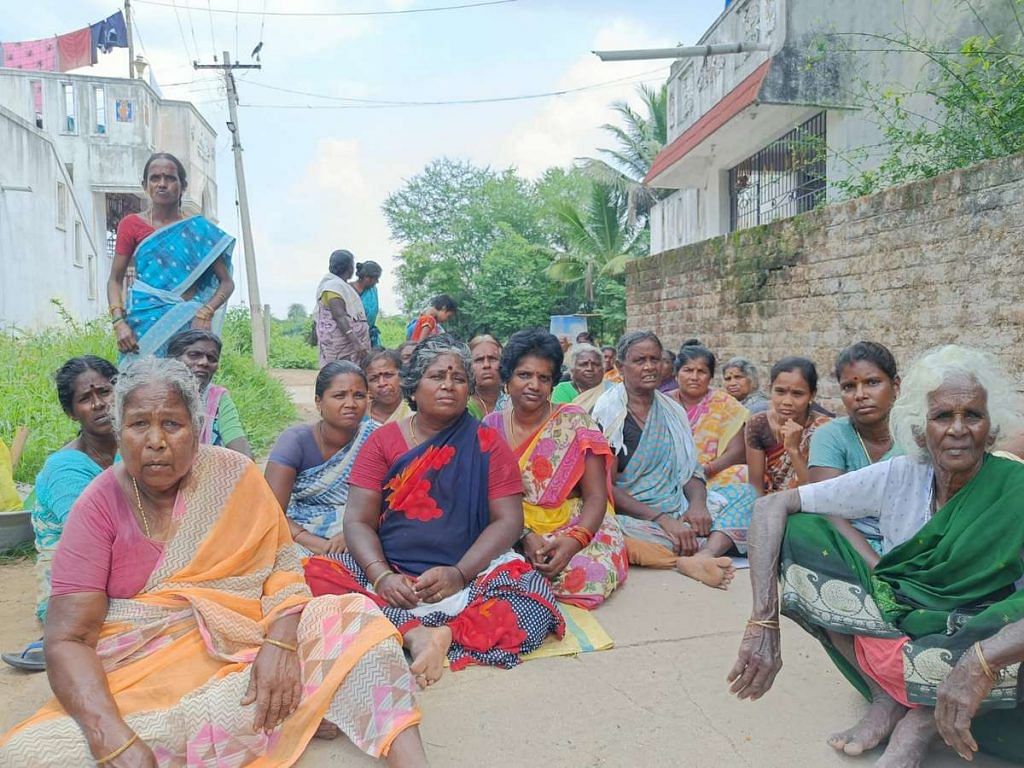
Many villagers ThePrint spoke to also mentioned how politicians who visited their villages ahead of the state elections in 2021 assured them that the airport wouldn’t come up in Parandur.
Some drew parallels with the massive agitation that the planned Chennai-Salem Expressway saw in 2018, when the DMK was in opposition. This project, sanctioned by the Union government for Rs 10,000 crore, was to span 277.3 km across eight lanes, with people expected to lose land, homes, and farms in six districts. Back then, the DMK had vigorously protested against the project.
Since then, it seems to have changed its stance. In September 2022, public works minister E.V. Velu said that the government would take a policy decision on the road project after speaking to stakeholders. He said that the DMK did not object to road infrastructure, but had issues when the former All India Anna Dravida Munnetra Kazhagam (AIADMK) government didn’t address the people’s concerns.
‘Government didn’t just land up in Parandur’
The Tamil Nadu government has maintained that it zeroed in on Parandur after a lot of deliberation and extensively scouting for appropriate locations. Government officials have said that they were keen to find something south of Chennai to cater to more passengers from within the state but had to settle for Parandur, located to the west.
Addressing the 2 November conference in the state capital, industries minister Thennarasu noted that he was often asked why the government didn’t just expand the existing airport.
“For us to expand this current airport, we’d need more than 300-400 acres. Surrounding the airport is a defence establishment on one side, a river on the other, a hillock, and lots of habitations. To create a good facility to cater to 10 crore people in the future, we are unable to do too much with the current airport,” he said.
Thennarasu said the government did not just “land up” at Parandur, and that the Airports Authority of India had surveyed over 16 sites before narrowing down the options to four potential sites.
“If you look around Chennai, on one side there is the Kalpakkam Atomic Energy Plant, on the other side the Tambaram Air base, down south Vedanthangal Bird Sanctuary, if you go north there is Pulicat Lake,” he said. “We can’t disturb these ecologically sensitive areas. Considering all this, the better place was the west side of the city, and we chose Parandur,” he said.
S. Krishnan, additional chief secretary in the industries department, who also spoke at the event, said that the government did not want to cause “any amount of distress” to the local communities, but added that some conflict of interest was inevitable.
“Ultimately every piece of infrastructure that gets created and built, has to be built affecting somebody’s interest. We have to make sure that their (local communities) interests are protected and addressed to the maximum extent possible,” he said.
Thennarasu also said that the project would have to be carried out in a way that ultimately benefited the local communities.
“This project is not only for the betterment of industry but to take care of the upliftment of the people living there. Our objective was to talk to them, convince them. We have been having several discussions,” he said.
Some of these efforts seem to be having an impact. For instance, villagers ThePrint met last month, spoke about plans of a protest walk to the Secretariat at Fort St George on 17 October to coincide with the first day of the legislative assembly’s proceedings.
Two days later, however, three ministers from the Tamil Nadu government — Thennarasu, public works minister E.V. Velu, and rural industries minister T.M. Anbarasan — held discussions with the villagers after which their plans were called off. The ministers promised compensation over three times beyond the value of their land and assured the villagers that adequate employment opportunities would be provided to them.
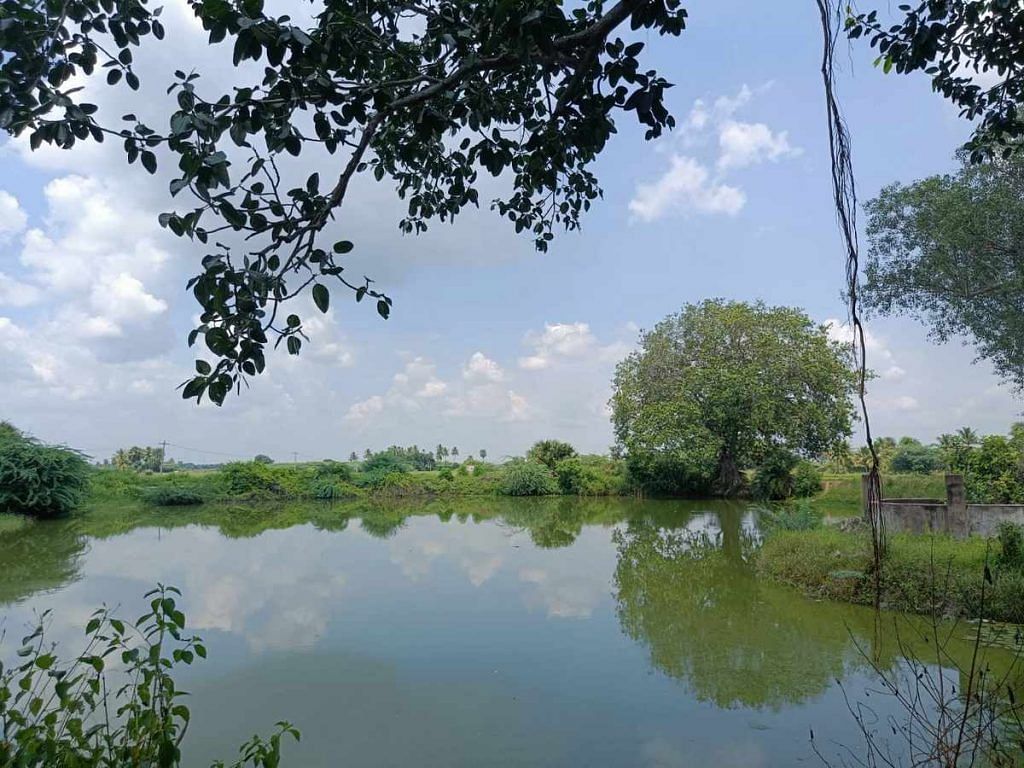
Worries about flooding, habitat loss
Some environmentalists are concerned that the airport project could have severe ecological impacts and worsen flooding, but the government has said that it has taken all these factors into account.
In a seven-page report released early last month, the Chennai-based environmental protection organisation Poovulagin Nanbargal warned the government of a potential “ecological disaster” if the airport is built.
It said that of the over 4,000 acres of land to be acquired for the project, 1,317 acres are classified as porambokku (wastelands). However, the report claimed that lakes, ponds, and small waterbodies cover nearly 955 acres of these ‘wastelands’, while grazing lands make up the rest.
“If the proposed airport is built, it will obstruct the flow of the 43 kilometre-long Kamban canal which fills nearly 85 lakes before emptying into the Sriperumbudur lake,” it added.
In an interview with the Indian Express in September, G. Sundarrajan of Poovulagin Nanbargal had said that the initial project map indicated that the airport’s runway would block a third-order stream — formed by the confluence of two other streams — and several water bodies. This, he noted, could flood the airport.
According to him, building an airport over a water body might have passed muster in the 1970s, but not at a time when climate change is wreaking havoc. The airport, he claimed, could worsen the situation in flood-prone Chennai.
The Tamil Nadu government says it has taken cognisance of this, too.
Krishnan emphasised at the conference that the government is well aware of the watershed area that surrounds Chennai. “What we need to ensure is to preserve the flow of water, and the way in which the water drains. We have to make sure we plan for that or we will have a problem of flooding in the new infrastructure,” he said.
The government has carried out a preliminary study and the project will be designed in such a way that it will minimise the impact on water bodies and will ensure adequate drainage, Krishnan added. An expert committee has also been established with members from the Indian Institute of Technology (IIT) Madras and the College of Engineering in Guindy.
“Resilience is very crucial while planning infrastructure and addressing concerns of the local communities. We want everyone to be a partner in this game, we want it to be everybody’s project and not just a few,” Krishnan said.
Specifically mentioning the village of Ekanapuram, which is located near one of the two proposed runways, Krishnan said the government was carrying out a technical feasibility study to find an alternative route.
An old way of life
Back in the villages, many seem to already be nostalgic about a way of life they’ve always known.
Showing off her back yard, Nagapattu resident Vasanthi pointed to thick patches of nilavembu. When the leaves are crushed and consumed as part of various concoctions, they can cure anything from a cold to a snakebite, she claimed.
All this greenery has taken years to nurture, she and her neighbour Mythili said. In return, the families enjoy an assortment of fruits and vegetables, apart from an abundance of shade from the harsh sun.
Another Nagapattu resident, K. Murugan, said the village had been self-sufficient during Covid-19 and it was their land that fed them.
“Imagine being asked to leave our homes and move all of a sudden?” he said. “Have you ever cultivated land? The smell of the mud is something else.”
(Edited by Asavari Singh)
Also read: In deadly dry Bundelkhand, Ken-Betwa link finally seems real. But critics have questions, fears


